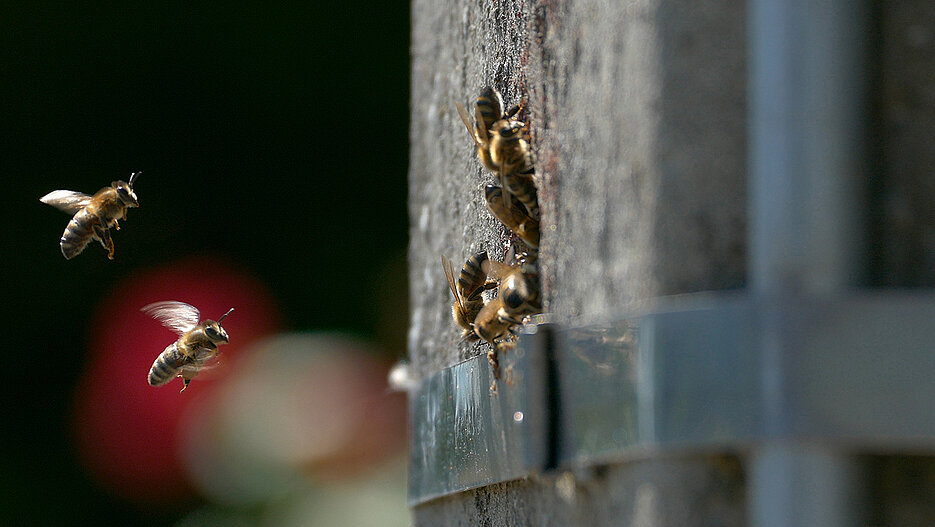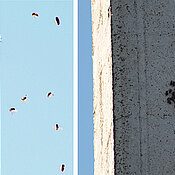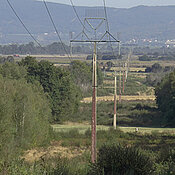Where Wild Honeybees Survive
02/16/2022In northern Spain, wild honeybees use hollow electricity poles as nesting cavities. Natural areas in the surroundings promote the colonies’ chances to survive the winter.

Until recently, experts considered it unlikely that the honeybee had survived as a wild animal in Europe. In a current study, biologists Benjamin Rutschmann and Patrick Kohl from Julius-Maximilians-Universität Würzburg (JMU) in Bavaria, Germany, show that wild honeybees still exist in the region of Galicia in the northwest of Spain.
The researchers describe where to find the bees’ nests and under which conditions they can survive in Biological Conservation, a journal for conservation biology.
136 square kilometres searched for power poles
Rutschmann and Kohl are doctoral students at the JMU Chair of Animal Ecology and Tropical Biology in the group of Professor Ingolf Steffan-Dewenter.
They started their studies in Galicia in October 2019 at the suggestion of their Spanish colleague Alejandro Machado. The latter had observed swarms of honeybees occupying the inside of hollow electricity poles and apparently thriving there. In order to find out whether the region would support an entire population of wild bee colonies, the researchers searched a 136 square kilometre area for hollow power poles.
"We discovered 214 poles," says Rutschmann. For each one, the researchers checked if a honeybee colony lived inside. "In the first year of our investigation, we found 29 colonies." On a second visit in March 2020, they found that 17 of these colonies had survived the winter - "even though they had neither been fed nor treated against parasites."
Galician honeybees are not imported breeds
Now, it could have been that the wild honeybee colonies were the feral descendants of foreign honeybee strains imported by beekeepers. In Germany, according to Rutschmann, the native honeybee subspecies (Apis mellifera mellifera) was displaced in this way a long time ago by imported subspecies, first and foremost by the Carnica bee (A. m. carnica).
But this was not the case in Galicia. By analysing wing venation pattern the JMU researchers discovered that all the colonies living in power poles were members of the Iberian honeybee, Apis mellifera iberiensis. It is thus conceivable that in Spain the honeybee has existed both as a wild and as a livestock animal up to the present day. "Whether the population under study can be stable in the long term, however, must be shown by further years of observation," says Kohl.
First data on survival rates
"After two years of study and a total of 52 observed bee colonies, we see that around 40 percent of the colonies survive the winter," reports Alejandro Machado, who himself lives in the region. This is the first data ever reported on the survival rates of wild honeybee colonies in Europe.
An analysis of the landscape around the power poles showed that the survival of the Galician honeybees strongly depends on how natural the surroundings are. In power poles surrounded by shrubland, heathland or forests many more colonies survive the winter than in power poles located in intensively cultivated fields.
For colonies surrounded by more than 50 per cent semi-natural habitats, at least every second colony survived the winter. In contrast, in landscapes with less than 25 per cent semi-natural habitat and therefore little supply of food, the probability of survival was close to zero.
Striking landscape contrasts in Galicia provided insights
In Galicia, the researchers found strong contrasts between contiguous semi-natural areas with no or traditional, extensive use (heathland, coppice) and large areas of intensive agriculture with high pesticide and fertiliser inputs.
"It was this stark contrast between quasi-nature and agricultural desert that made it possible for us to realise that the landscape context plays such an important role in the survival of honeybees," says Rutschmann.
The study shows the fundamental importance of extensive forms of land use and the restoration of near-natural landscape features such as hedgerows for insect conservation. "Without sufficient nesting and feeding habitats, even the banning of pesticides or the halt of climate change will not help insects," concludes Kohl.
Publication
Semi-natural habitats promote winter survival of wild-living honeybees in an agricultural landscape. Benjamin Rutschmann, Patrick L. Kohl, Alejandro Machado, Ingolf Steffan-Dewenter. Biological Conservation, January 2022, https://doi.org/10.1016/j.biocon.2022.109450
Correspondence
Benjamin Rutschmann, Biocentre, University of Würzburg, benjamin.rutschmann@uni-wuerzburg.de
Patrick Kohl, Biocentre, University of Würzburg, patrick.kohl@uni-wuerzburg.de











